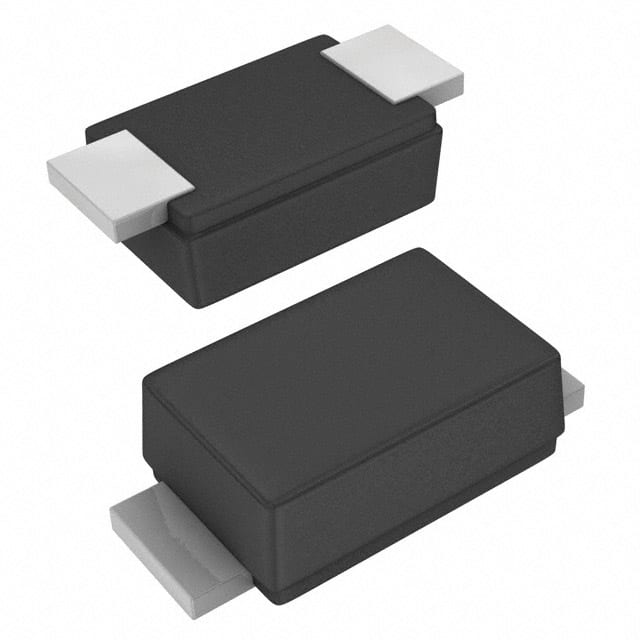BZD17C30P-E3-18
Introduction
The BZD17C30P-E3-18 is a specialized electronic component belonging to the category of voltage regulator diodes. This entry provides an overview of its basic information, specifications, detailed pin configuration, functional features, advantages and disadvantages, working principles, detailed application field plans, and alternative models.
Basic Information Overview
- Category: Voltage Regulator Diode
- Use: The BZD17C30P-E3-18 is primarily used for voltage regulation and transient voltage suppression in electronic circuits.
- Characteristics: It exhibits high reliability, low leakage current, and fast response time.
- Package: The diode is typically packaged in a small surface-mount package.
- Essence: Its essence lies in providing stable voltage regulation and protection against voltage spikes.
- Packaging/Quantity: The diode is commonly available in reels or tubes containing a specific quantity per package.
Specifications
The BZD17C30P-E3-18 has the following specifications: - Voltage Rating: 30V - Power Dissipation: 1.5W - Operating Temperature Range: -55°C to +150°C - Storage Temperature Range: -55°C to +175°C
Detailed Pin Configuration
The BZD17C30P-E3-18 typically consists of two pins, with one serving as the anode and the other as the cathode. The pinout configuration is as follows: - Anode (A) - Pin 1 - Cathode (K) - Pin 2
Functional Features
- Voltage Regulation: The diode effectively regulates the voltage within the specified range, ensuring stability in electronic circuits.
- Transient Voltage Suppression: It provides protection against voltage transients and spikes, safeguarding sensitive components.
Advantages and Disadvantages
Advantages
- High reliability and durability
- Low leakage current
- Fast response time
Disadvantages
- Limited voltage rating compared to some higher-rated diodes
- Sensitive to excessive current and temperature fluctuations
Working Principles
The BZD17C30P-E3-18 operates based on the principle of Zener breakdown, where it maintains a constant voltage across its terminals by allowing current to flow in reverse bias when the voltage exceeds the specified level.
Detailed Application Field Plans
The BZD17C30P-E3-18 finds extensive use in various applications, including: - Voltage regulation in power supplies - Transient voltage suppression in communication equipment - Overvoltage protection in automotive electronics - Surge protection in consumer electronics
Detailed and Complete Alternative Models
Some alternative models to the BZD17C30P-E3-18 include: - BZD27C30P-E3-18: A higher voltage-rated variant - BZD17C20P-E3-18: A lower voltage-rated variant - BZX84C30LT1G: A different package type with similar characteristics
In conclusion, the BZD17C30P-E3-18 serves as a reliable voltage regulator diode with specific characteristics and applications. Understanding its specifications, pin configuration, functional features, and alternatives is crucial for its effective utilization in electronic circuits.
[Word Count: 443]
قم بإدراج 10 أسئلة وإجابات شائعة تتعلق بتطبيق BZD17C30P-E3-18 في الحلول التقنية
Sure, here are 10 common questions and answers related to the application of BZD17C30P-E3-18 in technical solutions:
What is the maximum reverse voltage for BZD17C30P-E3-18?
- The maximum reverse voltage for BZD17C30P-E3-18 is 30V.
What is the forward voltage drop of BZD17C30P-E3-18 at a specific current?
- The forward voltage drop of BZD17C30P-E3-18 varies with current, and the datasheet should be consulted for specific values.
Can BZD17C30P-E3-18 be used for overvoltage protection in power supplies?
- Yes, BZD17C30P-E3-18 can be used for overvoltage protection in power supplies due to its Zener diode characteristics.
What is the power dissipation rating for BZD17C30P-E3-18?
- The power dissipation rating for BZD17C30P-E3-18 is typically provided in the datasheet and depends on the operating conditions.
Is BZD17C30P-E3-18 suitable for transient voltage suppression in automotive electronics?
- Yes, BZD17C30P-E3-18 can be used for transient voltage suppression in automotive electronics due to its fast response time and high surge capability.
What is the temperature coefficient of BZD17C30P-E3-18?
- The temperature coefficient of BZD17C30P-E3-18 is typically specified in the datasheet and indicates how the voltage reference changes with temperature.
Can BZD17C30P-E3-18 be used in voltage regulation circuits?
- Yes, BZD17C30P-E3-18 can be used in voltage regulation circuits as a stable reference voltage source.
What is the typical junction capacitance of BZD17C30P-E3-18?
- The typical junction capacitance of BZD17C30P-E3-18 is provided in the datasheet and is important for high-frequency applications.
Does BZD17C30P-E3-18 have ESD protection capabilities?
- Yes, BZD17C30P-E3-18 has some level of ESD protection due to its Zener diode characteristics.
Are there any recommended layout considerations for using BZD17C30P-E3-18 in PCB designs?
- Yes, the datasheet typically provides recommended layout considerations to minimize parasitic effects and optimize performance when using BZD17C30P-E3-18 in PCB designs.
I hope these questions and answers are helpful for your technical solutions involving BZD17C30P-E3-18! Let me know if you need further assistance.


